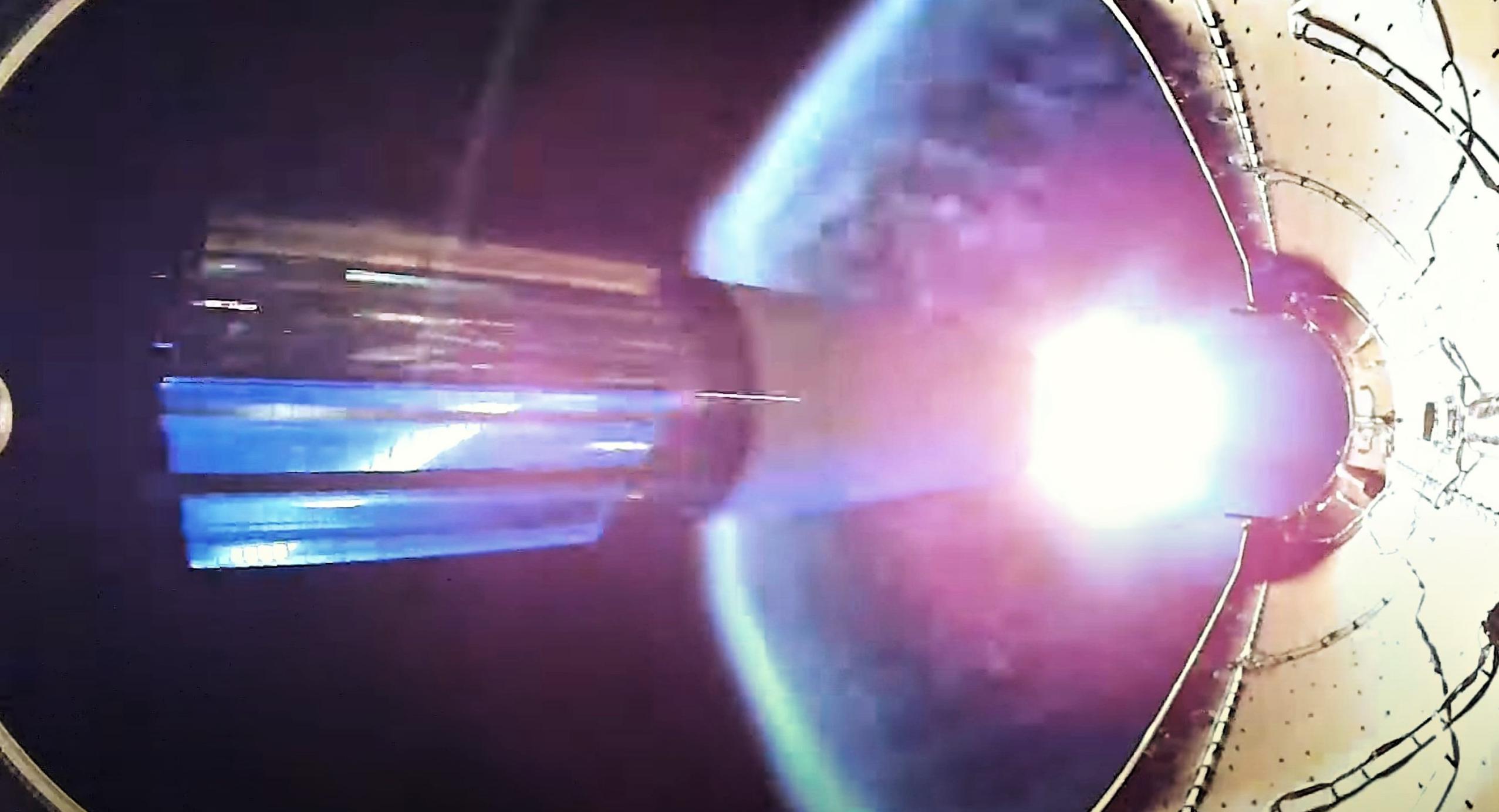
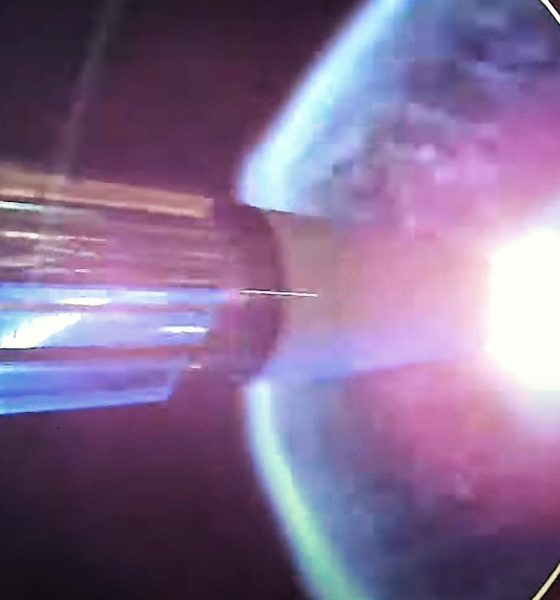
News
Here’s what SpaceX’s first Starlink satellite rideshare mission looks like [photo]
By way of customer Planet, SpaceX has published the first view of its inaugural Starlink satellite rideshare mission, revealing three mini fridge-sized Earth imaging satellites perched on a stack of dozens of Starlink spacecraft.
Scheduled to launch no earlier than (NET) 5:21 am (09:21 UTC) on June 13th, SpaceX’s eighth launch of Starlink v1.0 satellites (Starlink V1 L8) could usher in a revolutionary new way for smallsat operators to get their spacecraft in orbit. The company’s first Starlink rideshare customer has become a vocal supporter in the days before the first launch, praising unprecedentedly low launch costs SpaceX is able to offer. In fact, executives of Planet – now the world’s second most prolific satellite launcher after SpaceX – were so surprised at the prices the launch company was charging that they “could not believe what [they] were looking at”.
To account for the mass added by three Planet SkySats (~350 kg or 770 lb), SpaceX revealed earlier today that it had removed two Starlink satellites – each weighing ~260 kg (570 lb) – from the original stack of 60 spacecraft. Aside from confirming that Falcon 9 is balancing at the very edge of its performance envelope to launch ~16 metric tons (~35,000 lb) of satellites while still enabling booster recovery, the removal of two Starlink satellites to make way for rideshare payloads hints at an incredible level of flexibility available to SpaceX.
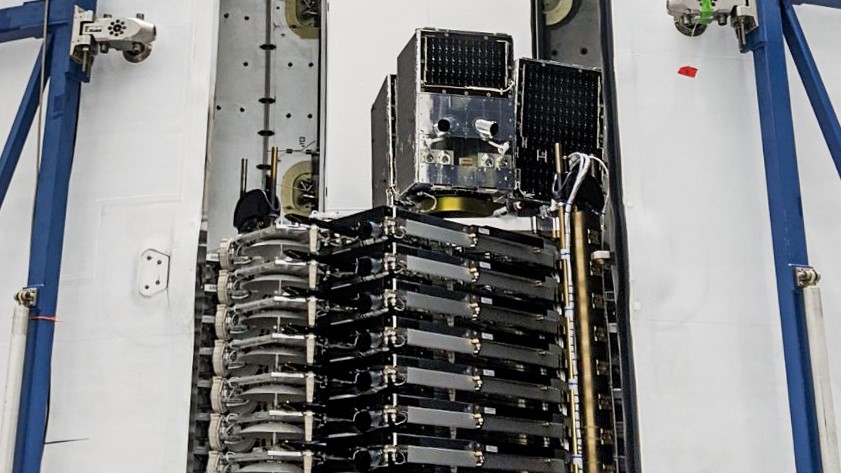
For customers of the fledgling small satellite rideshare program interested in procuring launch services directly, Planet’s SkySats are almost perfectly sized to extract the most bang for the buck from SpaceX’s current pricing system. Planet likely spent a bit more to have SpaceX build it a custom adapter and deployment mechanism for two launches, but the company’s launch costs for six SkySats – split between two June 2020 Starlink missions – could be as low as $6 million based on SpaceX’s own calculator. Due to the general secrecy of launch prices, it’s hard to accurately compare, but Planet would have had to pay upwards of $40 million – almost seven times as much – to launch six SkySats on dedicated Rocket Lab Electron rockets.
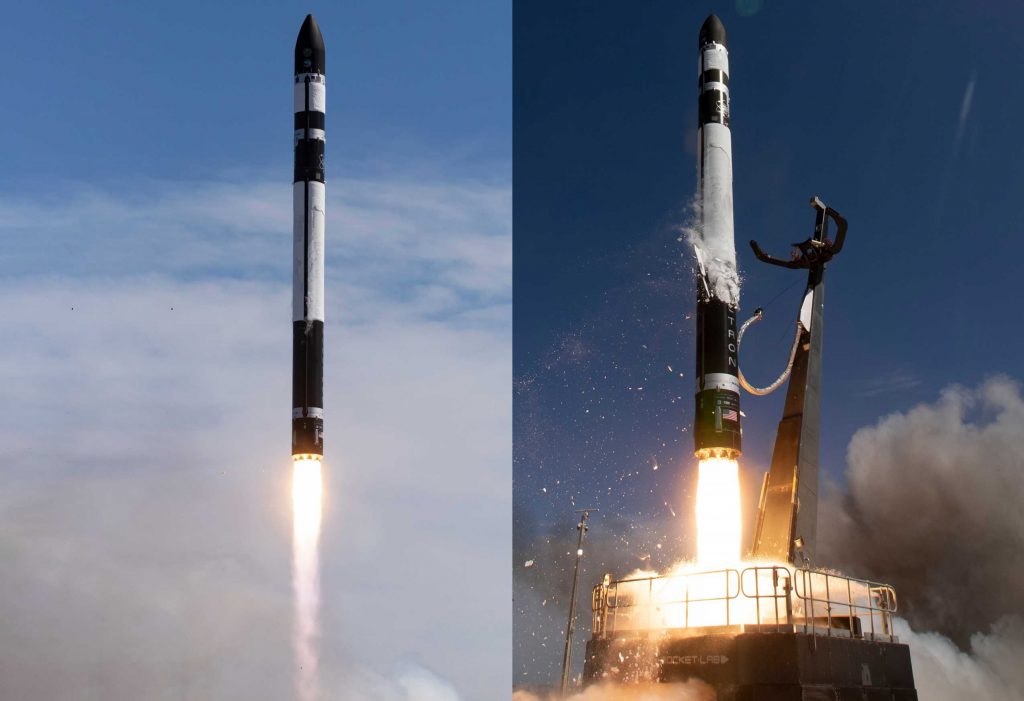
In return for $5-30+ million dollars in savings, Planet’s six new SkySats will have to work to raise their orbits from around 300 to 450 kilometers (190-280 mi) after deploying from SpaceX’s Starlink satellite stack. That work will expend a significant portion of their propellant reserves, likely cutting several months (up to several years) off of their operational lifespans. Believed to cost around $3-5 million each, however, the money Planet has saved by launching SkySats with SpaceX could potentially pay for an entirely new batch of six more satellites (or more).
With cost savings like that at hand, it’s no wonder that Planet’s Mike Safyan – Vice President of Launch – described SpaceX’s Starlink rideshare program as “incredibly competitive” and “one of the more significant programs for the smallsat industry”. Having overseen the launch of hundreds of Planet’s Dove and SkySat satellites over the last nine years, it would be hard to find a more qualified industry voice on the subject. Indeed, the rest of the smallsat industry is also responding positively to SpaceX’s new offering, with dozens of commercial spacecraft already assigned to future rideshare launches.
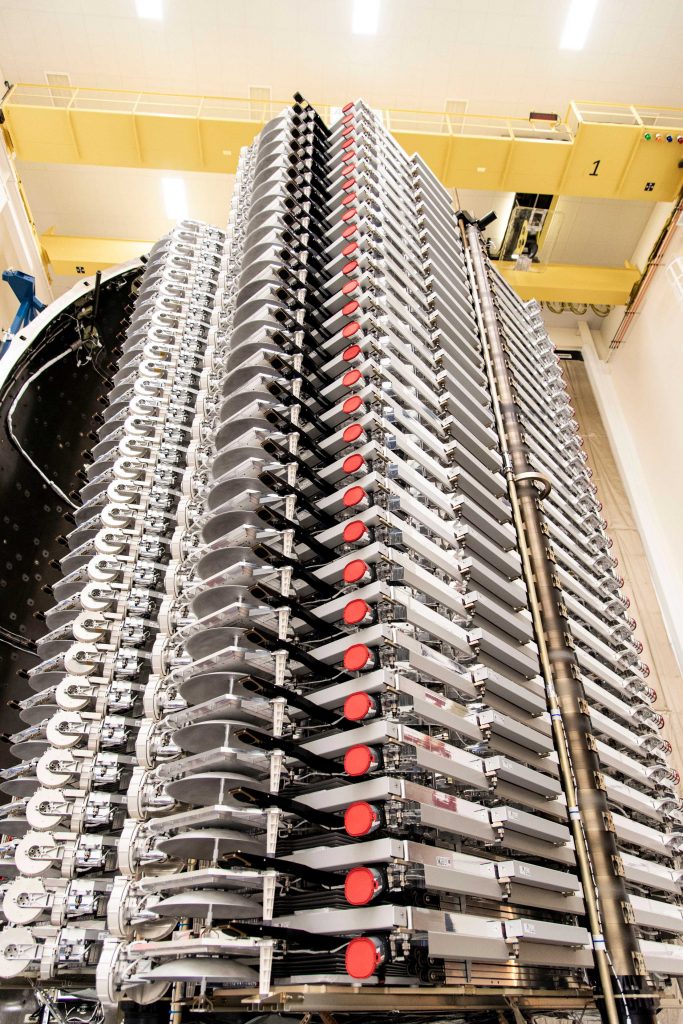
At this point, SpaceX plans to offer rideshare opportunities on Starlink missions every month for the indefinite future, all while charging as little as a $1 million per slot. Thanks to third-party launch services companies like Spaceflight and Exolaunch, much smaller cubesats and nanosats will also have ways to get into orbit on SpaceX rockets for much less than the company’s base price. Meanwhile, scheduled to launch no earlier than June 22nd, SpaceX’s very next Starlink launch – V1 L9 – is expected to include three more Planet SkySats and two similar BlackSky imaging satellites.
If SpaceX can maintain the impressive inertia of its Starlink launch and rideshare efforts, it’s safe to say that the company is going to be a towering presence in the smallsat launch industry for the foreseeable future.
Check out Teslarati’s Marketplace! We offer Tesla accessories, including for the Tesla Cybertruck and Tesla Model 3.

Elon Musk
Tesla CEO Elon Musk teases insane capabilities of next major FSD update

Tesla CEO Elon Musk teased the insane capabilities of the next major Full Self-Driving update just hours after the company rolled out version 14.2 to owners.
Tesla Full Self-Driving v14.2 had some major improvements from the previous iteration of v14.1.x. We were on v14.1.7, the most advanced configuration of the v14.1 family, before Tesla transitioned us and others to v14.2.
However, Musk has said that the improvements coming in the next major update, which will be v14.3, will be where “the last big piece of the puzzle finally lands.”
14.3 is where the last big piece of the puzzle finally lands
— Elon Musk (@elonmusk) November 21, 2025
There were some major improvements with v14.2, most notably, Tesla seemed to narrow in on the triggers that caused issues with hesitation and brake stabbing in v14.1.x.
One of the most discussed issues with the past rollout was that of brake stabbing, where the vehicle would contemplate proceeding with a route as traffic was coming from other directions.
We experienced it most frequently at intersections, especially four-way stop signs.
Elon Musk hints at when Tesla can fix this FSD complaint with v14
In our review of it yesterday, it was evident that this issue had been resolved, at least to the extent that we had no issues with it in a 62-minute drive, which you can watch here.
Some owners also reported a more relaxed driver monitoring system, which is something Tesla said it was working on as it hopes to allow drivers to text during operation in the coming months. We did not test this, as laws in Pennsylvania prohibit the use of phones at any time due to the new Paul Miller’s Law, which took effect earlier this year.
However, the improvements indicate that Tesla is certainly headed toward a much more sentient FSD experience, so much so that Musk’s language seems to be more indicative of a more relaxed experience in terms of overall supervision from the driver, especially with v14.3.
Musk did not release or discuss a definitive timeline for the release of v14.3, especially as v14.2 just rolled out to Early Access Program (EAP) members yesterday. However, v14.1 rolled out to Tesla owners just a few weeks ago in late 2025. There is the potential that v14.3 could be part of the coming Holiday Update, or potentially in a release of its own before the New Year.
News
Tesla Full Self-Driving v14.2 – Full Review, the Good and the Bad

Tesla rolled out Full Self-Driving version 14.2 yesterday to members of the Early Access Program (EAP). Expectations were high, and Tesla surely delivered.
With the rollout of Tesla FSD v14.2, there were major benchmarks for improvement from the v14.1 suite, which spanned across seven improvements. Our final experience with v14.1 was with v14.1.7, and to be honest, things were good, but it felt like there were a handful of regressions from previous iterations.
While there were improvements in brake stabbing and hesitation, we did experience a few small interventions related to navigation and just overall performance. It was nothing major; there were no critical takeovers that required any major publicity, as they were more or less subjective things that I was not particularly comfortable with. Other drivers might have been more relaxed.
With v14.2 hitting our cars yesterday, there were a handful of things we truly noticed in terms of improvement, most notably the lack of brake stabbing and hesitation, a major complaint with v14.1.x.
However, in a 62-minute drive that was fully recorded, there were a lot of positives, and only one true complaint, which was something we haven’t had issues with in the past.
The Good
Lack of Brake Stabbing and Hesitation
Perhaps the most notable and publicized issue with v14.1.x was the presence of brake stabbing and hesitation. Arriving at intersections was particularly nerve-racking on the previous version simply because of this. At four-way stops, the car would not be assertive enough to take its turn, especially when other vehicles at the same intersection would inch forward or start to move.
This was a major problem.
However, there were no instances of this yesterday on our lengthy drive. It was much more assertive when arriving at these types of scenarios, but was also more patient when FSD knew it was not the car’s turn to proceed.
Can report on v14.2 today there were ZERO instances of break stabbing or hesitation at intersections today
It was a significant improvement from v14.1.x
— TESLARATI (@Teslarati) November 21, 2025
This improvement was the most noticeable throughout the drive, along with fixes in overall smoothness.
Speed Profiles Seem to Be More Reasonable
There were a handful of FSD v14 users who felt as if the loss of a Max Speed setting was a negative. However, these complaints will, in our opinion, begin to subside, especially as things have seemed to be refined quite nicely with v14.2.
Freeway driving is where this is especially noticeable. If it’s traveling too slow, just switch to a faster profile. If it’s too fast, switch to a slower profile. However, the speeds seem to be much more defined with each Speed Profile, which is something that I really find to be a huge advantage. Previously, you could tell the difference in speeds, but not in driving styles. At times, Standard felt a lot like Hurry. Now, you can clearly tell the difference between the two.
It seems as if Tesla made a goal that drivers should be able to tell which Speed Profile is active if it was not shown on the screen. With v14.1.x, this was not necessarily something that could be done. With v14.2, if someone tested me on which Speed Profile was being used, I’m fairly certain I could pick each one.
Better Overall Operation
I felt, at times, especially with v14.1.7, there were some jerky movements. Nothing that was super alarming, but there were times when things just felt a little more finicky than others.
v14.2 feels much smoother overall, with really great decision-making, lane changes that feel second nature, and a great speed of travel. It was a very comfortable ride.
The Bad
Parking
It feels as if there was a slight regression in parking quality, as both times v14.2 pulled into parking spots, I would have felt compelled to adjust manually if I were staying at my destinations. For the sake of testing, at my first destination, I arrived, allowed the car to park, and then left. At the tail-end of testing, I walked inside the store that FSD v14.2 drove me to, so I had to adjust the parking manually.
This was pretty disappointing. Apart from parking at Superchargers, which is always flawless, parking performance is something that needs some attention. The release notes for v14.2. state that parking spot selection and parking quality will improve with future versions.
Any issues with parking on your end? 14.1.7 didn’t have this trouble with parking pic.twitter.com/JPLRO2obUj
— TESLARATI (@Teslarati) November 21, 2025
However, this was truly my only complaint about v14.2.
You can check out our full 62-minute ride-along below:
Elon Musk
SpaceX issues statement on Starship V3 Booster 18 anomaly
The incident unfolded during gas-system pressure testing at the company’s Massey facility in Starbase, Texas.

SpaceX has issued an initial statement about Starship Booster 18’s anomaly early Friday. The incident unfolded during gas-system pressure testing at the company’s Massey facility in Starbase, Texas.
SpaceX’s initial comment
As per SpaceX in a post on its official account on social media platform X, Booster 18 was undergoing gas system pressure tests when the anomaly happened. Despite the nature of the incident, the company emphasized that no propellant was loaded, no engines were installed, and personnel were kept at a safe distance from the booster, resulting in zero injuries.
“Booster 18 suffered an anomaly during gas system pressure testing that we were conducting in advance of structural proof testing. No propellant was on the vehicle, and engines were not yet installed. The teams need time to investigate before we are confident of the cause. No one was injured as we maintain a safe distance for personnel during this type of testing. The site remains clear and we are working plans to safely reenter the site,” SpaceX wrote in its post on X.
Incident and aftermath
Livestream footage from LabPadre showed Booster 18’s lower half crumpling around the liquid oxygen tank area at approximately 4:04 a.m. CT. Subsequent images posted by on-site observers revealed extensive deformation across the booster’s lower structure. Needless to say, spaceflight observers have noted that Booster 18 would likely be a complete loss due to its anomaly.
Booster 18 had rolled out only a day earlier and was one of the first vehicles in the Starship V3 program. The V3 series incorporates structural reinforcements and reliability upgrades intended to prepare Starship for rapid-reuse testing and eventual tower-catch operations. Elon Musk has been optimistic about Starship V3, previously noting on X that the spacecraft might be able to complete initial missions to Mars.








